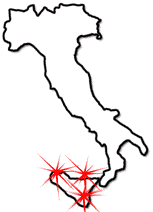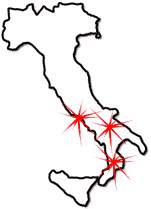Pilots of the 99th Squadron joined the 33rd Fighter Group in Fardjouna on May 31, 1943. This relocation brought the group closer to the realities of combat where they saw planes return damaged and combat weary and realized others did not return at all.
On June 2, 1943, Lt William A. Campbell, Charles B. Hall, Clarence C. Jamison and James R. Wiley, were the first members of the Black Squadron to fly in a mission. This first flight mission to Pantelleria was uneventful. In fact, missions were slow for a week before the group encountered the first enemy planes.
Led by Lt Charles Dryden, Lt Willie Ashley, Sidney P. Brooks, Lee Rayford, Leon Roberts and Spann Watson, exchanged fire with German fighter planes. Although the group lacked combat experience, they maintained offensive focus, and forced the Germans to retreat. The persistent air assault of the 33rd and the 99th, led to the surrender of the Italian island of Pantelleria.
![]()
The 99th joined the 324th Fighter Group in El Haouria on June 29, 1943. Their initial assignment involved escorting medium bombers to different points along the Sicilian coast. It was on one such escort mission, on July 2, 1943, that Lt Charles B. Hall of Indiana became the first member of the squadron to shoot down a German Focke Wulf 190 aircraft.
Celebration of Hall's success was diluted by the fact that Lt Dryden had been attacked by enemy aircraft and Lt. Sherman White Jr. and James L. McCullin died when their aircraft collided on takeoff.
 The 99th continued to escort medium bombers to Sicily, and flew over
175 dive bombing and strafing missions. Finally, the superior Allied
forces stormed the beaches and took control of the enemy position. Lt
Richard Bolling of Virginia was shot down and after parachuting from his
burning plane he was forced to drift for over 24 hours before he was
rescued and sent back to North Africa.
The 99th continued to escort medium bombers to Sicily, and flew over
175 dive bombing and strafing missions. Finally, the superior Allied
forces stormed the beaches and took control of the enemy position. Lt
Richard Bolling of Virginia was shot down and after parachuting from his
burning plane he was forced to drift for over 24 hours before he was
rescued and sent back to North Africa.
With the Allied troops advancing along the western and eastern shores of Sicily, the 99th was reassigned to Licata on the coast of the Mediterranean Sea on July 19th. On July 23rd five replacement pilots joined the squadron. By the time the Allied forces had capture the island of Sicily on August 25, 1943, the 99th had lost one more member. On August 11, the aircrafts of Lt Paul Mitchell and Samuel Bruce collided; while Bruce was able to parachute to safety, Mitchell was killed.
![]()
Col. William Momyer was the commander of the 33rd and an opponent of the 99th Fighter Squadron. Momyer was particularly vocal about the lack of victories scored by the 99th, making unfair comparisons to his more "successful" White team. He suggested that the squadron lacked air discipline and the ability to work as a team or respond aggressively when threatened by enemy fire.
Momyer failed to inform that the 99th scored fewer victories because they were not a part of the invasion force but were in support services several hundred miles from the battlefront. Additionally, members of the 99th had reported incidents where Momyer excluded them from briefing sessions for missions they were expected to fly with the 33rd. This obvious prejudicial tactic held life threatening implications for the 99th as they were flying missions though ill-informed of the strategy. The 99th had to be preoccupied with the enemy within their own ranks as much as they had to focus on the German enemy without.
The negative, though unjustified, criticism levied against the 99th by Momyer, was reported in a September 20, 1943 "Time Magazine" article. The article suggested that not only was there dissatisfaction with the performance of the Squadron, Air Force officials were considering disbanding the group.
This added negative pressure to an already difficult situation. The 99th was already handicapped by race-based biases that most often relegated them to "menial" roles; not because of their unwillingness or ability to fight but because they were Black. To compound the situation, the squadron was also acutely aware that their performance would determine the future access of Blacks to the Air Corps. They felt that the best way to silence their critics was to carry out their assigned mission flawlessly.
![]()
 Italy was considered a strategic point of control for the Allied
forces against Germany and its capture became part of a two-pronged
approach. While the British Eighth Army's 13th Corps and the Desert Air
Force were scheduled to capture Reggio Calabria on September 3, 1943,
the Fifth U.S. Army would capture Salerno. Termed "Avalanche
Force" the plan would be executed on September 9, D-Day.
Italy was considered a strategic point of control for the Allied
forces against Germany and its capture became part of a two-pronged
approach. While the British Eighth Army's 13th Corps and the Desert Air
Force were scheduled to capture Reggio Calabria on September 3, 1943,
the Fifth U.S. Army would capture Salerno. Termed "Avalanche
Force" the plan would be executed on September 9, D-Day.
The 99th was part of the U.S. air support for the ground mission. The enemy forces provided no initial aerial opposition, making the mission uneventful for the air support team. However on September 13th, the Germans attacked with such force that the allies were forced to retreat.
In response, all available personnel including an advance team of the 99th who had recently arrived in Italy, were used in response to the German show of offensive power. Because of the urgency of the situation the 99th combat inexperience was overlooked. Meanwhile, the core group of the 99th's Air Force was still on Sicily's north coast, providing escort and monitoring the shipping area.
Finally, on September 23, 1943, 10 members of the 99th Flight Squadron were sent to Paestum after the Montecorvino airport, near Salerno, was captured by the Allied forces. Their main role was patrolling the areas surrounding Salerno.
![]()
 Copyright © 2001-, Terry Muse
Copyright © 2001-, Terry Muse
Revised: December 30, 2001
URL: http://black_and_hispanic.tripod.com/blackhistory/
Contact: Terry Muse